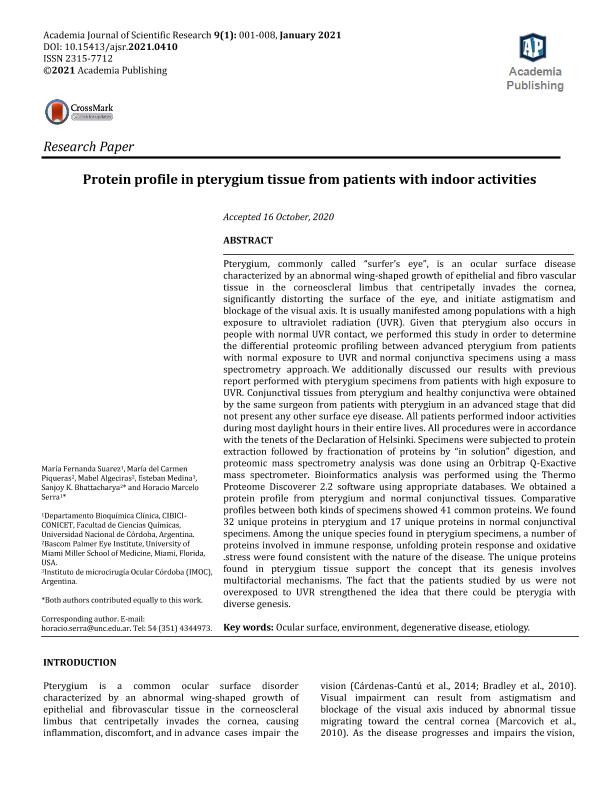Artículo
Protein profile in pterygium tissue from patients with indoor activities
Suarez, Maria Fernanda ; Piqueras, Carmen; Algeciras, Mabel; Medina, Esteban Roberto; Bhattacharya, Sanjoy K.; Serra, Horacio Marcelo
; Piqueras, Carmen; Algeciras, Mabel; Medina, Esteban Roberto; Bhattacharya, Sanjoy K.; Serra, Horacio Marcelo
 ; Piqueras, Carmen; Algeciras, Mabel; Medina, Esteban Roberto; Bhattacharya, Sanjoy K.; Serra, Horacio Marcelo
; Piqueras, Carmen; Algeciras, Mabel; Medina, Esteban Roberto; Bhattacharya, Sanjoy K.; Serra, Horacio Marcelo
Fecha de publicación:
07/2021
Editorial:
Academia Publishing
Revista:
Academia Journal of Scientific Research
ISSN:
2315-7712
Idioma:
Inglés
Tipo de recurso:
Artículo publicado
Clasificación temática:
Resumen
Pterygium, commonly called “surfer’s eye”, is an ocular surface disease characterized by an abnormal wing-shaped growth of epithelial and fibro vascular tissue in the corneoscleral limbus that centripetally invades the cornea, significantly distorting the surface of the eye, and initiate astigmatism and blockage of the visual axis. It is usually manifested among populations with a high exposure to ultraviolet radiation (UVR). Given that pterygium also occurs in people with normal UVR contact, we performed this study in order to determine the differential proteomic profiling between advanced pterygium from patients with normal exposure to UVR and normal conjunctiva specimens using a mass spectrometry approach. We additionally discussed our results with previous report performed with pterygium specimens from patients with high exposure to UVR. Conjunctival tissues from pterygium and healthy conjunctiva were obtained by the same surgeon from patients with pterygium in an advanced stage that did not present any other surface eye disease. All patients performed indoor activities during most daylight hours in their entire lives. All procedures were in accordance with the tenets of the Declaration of Helsinki. Specimens were subjected to protein extraction followed by fractionation of proteins by “in solution” digestion, and proteomic mass spectrometry analysis was done using an Orbitrap Q-Exactive mass spectrometer. Bioinformatics analysis was performed using the Thermo Proteome Discoverer 2.2 software using appropriate databases. We obtained a protein profile from pterygium and normal conjunctival tissues. Comparative profiles between both kinds of specimens showed 41 common proteins. We found 32 unique proteins in pterygium and 17 unique proteins in normal conjunctival specimens. Among the unique species found in pterygium specimens, a number of proteins involved in immune response, unfolding protein response and oxidative .stress were found consistent with the nature of the disease. The unique proteins found in pterygium tissue support the concept that its genesis involves multifactorial mechanisms. The fact that the patients studied by us were not overexposed to UVR strengthened the idea that there could be pterygia with diverse genesis.
Palabras clave:
PTERIGYUM
,
HUMAN
,
MASS SPECTROMETRY
Archivos asociados
Licencia
Identificadores
Colecciones
Articulos(CIBICI)
Articulos de CENTRO DE INV.EN BIOQUI.CLINICA E INMUNOLOGIA
Articulos de CENTRO DE INV.EN BIOQUI.CLINICA E INMUNOLOGIA
Citación
Suarez, Maria Fernanda; Piqueras, Carmen; Algeciras, Mabel; Medina, Esteban Roberto; Bhattacharya, Sanjoy K.; et al.; Protein profile in pterygium tissue from patients with indoor activities; Academia Publishing; Academia Journal of Scientific Research; 9; 1; 7-2021; 1-8
Compartir



